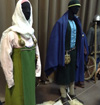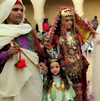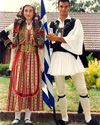Home
 The Carpathian regions of Ukraine are famous for their traditional crafts and clothing. Nowhere else in Ukraine will you find as richly embellished and outstanding outfits as the clothing used by Ukrainian Hutsuls. These highlanders are very proud, skillful, and hardworking people. And all of that is reflected in their traditional costumes. Some pieces of clothing are used only in Carpathian regions and are really unique. If you haven't seen Hutsul folk costumes, you can't have the full picture of Ukrainian heritage in the art of traditional dressing.
The Carpathian regions of Ukraine are famous for their traditional crafts and clothing. Nowhere else in Ukraine will you find as richly embellished and outstanding outfits as the clothing used by Ukrainian Hutsuls. These highlanders are very proud, skillful, and hardworking people. And all of that is reflected in their traditional costumes. Some pieces of clothing are used only in Carpathian regions and are really unique. If you haven't seen Hutsul folk costumes, you can't have the full picture of Ukrainian heritage in the art of traditional dressing.
- Details
- Category: Ukraine
- Hits: 35158
 A loom is a machine used to weave cloth. Weaving is one of the oldest crafts in the world. Hundreds of years ago people used to make all their clothes at home. They grew special plants and animals, made yarn, wove cloth and sewed clothing. Nowadays almost all kinds of fabric are made industrially. But even today some people continue their grandmother's work and weave cloth with a help of small wooden looms. It is really interesting to compare several different looms. They may have diverse construction and elements, but their principles of work are mostly the same.
A loom is a machine used to weave cloth. Weaving is one of the oldest crafts in the world. Hundreds of years ago people used to make all their clothes at home. They grew special plants and animals, made yarn, wove cloth and sewed clothing. Nowadays almost all kinds of fabric are made industrially. But even today some people continue their grandmother's work and weave cloth with a help of small wooden looms. It is really interesting to compare several different looms. They may have diverse construction and elements, but their principles of work are mostly the same.
- Details
- Category: Ukraine
- Hits: 26029
 Tunisians are among the best in the world in creating distinctive signs of their origin. It's not only the design of a veil or dress for women and jebba for men – it's the whole image: clothing, make-up, hair-do, shoes, headdress, jewelry, and accessories. To emphasize their identity, Tunisian people need such clothing crafts as weaving and embroidering. Local craftsmen have achieved excellence in making the most exquisite and high-quality clothing. That's why Tunisians still use the traditional costumes in day-to-day life.
Tunisians are among the best in the world in creating distinctive signs of their origin. It's not only the design of a veil or dress for women and jebba for men – it's the whole image: clothing, make-up, hair-do, shoes, headdress, jewelry, and accessories. To emphasize their identity, Tunisian people need such clothing crafts as weaving and embroidering. Local craftsmen have achieved excellence in making the most exquisite and high-quality clothing. That's why Tunisians still use the traditional costumes in day-to-day life.
- Details
- Category: Tunisia
- Hits: 67676
 The traditional clothing of Colombia is very diverse, bright, and eccentric. It is also considered to be iconic for the whole Latin America. Besides, locals keep their clothing traditions and wear folk dresses in day-to-day life. And it shouldn't surprise you – Colombian traditional costumes are made from the natural materials; they are colorful, light, beautiful, and comfy.
The traditional clothing of Colombia is very diverse, bright, and eccentric. It is also considered to be iconic for the whole Latin America. Besides, locals keep their clothing traditions and wear folk dresses in day-to-day life. And it shouldn't surprise you – Colombian traditional costumes are made from the natural materials; they are colorful, light, beautiful, and comfy.
- Details
- Category: Colombia
- Hits: 111087
 Ukrainian traditional clothing of the end of the 19th century – the early 20th century still had a lot of features historically typical for this country. Women used embroidered garments, bonnet-like headdresses, colorful pieces of clothes, woven items, and richly decorated outerwear and bags. Today most of such vintage outfits belong to museums and private collectors. The costumes we'd like to show you right now belong to the large collection of the National Museum of the History of Ukraine.
Ukrainian traditional clothing of the end of the 19th century – the early 20th century still had a lot of features historically typical for this country. Women used embroidered garments, bonnet-like headdresses, colorful pieces of clothes, woven items, and richly decorated outerwear and bags. Today most of such vintage outfits belong to museums and private collectors. The costumes we'd like to show you right now belong to the large collection of the National Museum of the History of Ukraine.
- Details
- Category: Ukraine
- Hits: 42027
 Modern Lebanon is a very fashionable country, one of the most stylish in the whole Arab world. But the majority of Lebanese wear western-style clothing today, instead of their own traditional outfits. The national costumes of Lebanon are still worn in the rural areas where traditions are kept more thoroughly. But clothing traditions of this country are as diverse as the ethnic composition of Lebanon. During its history, the country was under the rule of Roman, Persian, Greek, Arab, Ottoman Empires, and also France recently. Each of them left a trace in the life and traditions of Lebanon. And it makes Lebanese traditional costume all the more interesting.
Modern Lebanon is a very fashionable country, one of the most stylish in the whole Arab world. But the majority of Lebanese wear western-style clothing today, instead of their own traditional outfits. The national costumes of Lebanon are still worn in the rural areas where traditions are kept more thoroughly. But clothing traditions of this country are as diverse as the ethnic composition of Lebanon. During its history, the country was under the rule of Roman, Persian, Greek, Arab, Ottoman Empires, and also France recently. Each of them left a trace in the life and traditions of Lebanon. And it makes Lebanese traditional costume all the more interesting.
- Details
- Category: Lebanon
- Hits: 70090
 People in different regions of Tunisia often wear radically different outfits. Especially if to talk about women. Traditional clothing typical for some Tunisian cities include long multilayered dresses with intricate headgears, in other cases baggy trousers, short tops and jackets are used, and sometimes traditional Tunisian garments are pretty similar to those worn in European countries today. Here are some photos that illustrate the diversity of vintage outfits used in different regions of Tunisia.
People in different regions of Tunisia often wear radically different outfits. Especially if to talk about women. Traditional clothing typical for some Tunisian cities include long multilayered dresses with intricate headgears, in other cases baggy trousers, short tops and jackets are used, and sometimes traditional Tunisian garments are pretty similar to those worn in European countries today. Here are some photos that illustrate the diversity of vintage outfits used in different regions of Tunisia.
- Details
- Category: Tunisia
- Hits: 36402
 Every part of the national costume of any country was created according to the traditions, beliefs, and environmental conditions. And shoes aren't an exception. In fact, they are often the most demonstrative piece of a traditional outfit. There are plenty of extraordinary and even odd shoes that are being used by millions of people for centuries, no matter how inconvenient and strange such footwear can be. We chose for you 10 most unique and offbeat traditional shoes in the world.
Every part of the national costume of any country was created according to the traditions, beliefs, and environmental conditions. And shoes aren't an exception. In fact, they are often the most demonstrative piece of a traditional outfit. There are plenty of extraordinary and even odd shoes that are being used by millions of people for centuries, no matter how inconvenient and strange such footwear can be. We chose for you 10 most unique and offbeat traditional shoes in the world.
- Details
- Category: Nationalclothing
- Hits: 24915
 Let us present you the collection of the traditional costumes of European and Asian countries (the 9th-10th century). There are photos of the traditional clothing of Kievan Rus' (with the center in Kyiv, Ukraine), Sweden, Denmark, Russia, and Hungary. All of these outfits are reconstructions, though they are very accurate and archaeologically confirmed. There are costumes of nobility, warriors, and peasants among the samples. The clothing, shoes, jewelry, and other accessories are handmade; clothes is hand-dyed.
Let us present you the collection of the traditional costumes of European and Asian countries (the 9th-10th century). There are photos of the traditional clothing of Kievan Rus' (with the center in Kyiv, Ukraine), Sweden, Denmark, Russia, and Hungary. All of these outfits are reconstructions, though they are very accurate and archaeologically confirmed. There are costumes of nobility, warriors, and peasants among the samples. The clothing, shoes, jewelry, and other accessories are handmade; clothes is hand-dyed.
- Details
- Category: Nationalclothing
- Hits: 43931
 These photos represent the traditional costumes of Ukraine used at the end of the 19th – beginning of the 20th century. All the costumes today belong to the private collections of Vira Matkovska and Olena Didyk. The outfits are shown to the public pretty seldom. The main features of garments used during this specified period of time are bright colors, dense embroidery, beautiful and colorful headdresses, and a small amount of jewelry.
These photos represent the traditional costumes of Ukraine used at the end of the 19th – beginning of the 20th century. All the costumes today belong to the private collections of Vira Matkovska and Olena Didyk. The outfits are shown to the public pretty seldom. The main features of garments used during this specified period of time are bright colors, dense embroidery, beautiful and colorful headdresses, and a small amount of jewelry.
- Details
- Category: Ukraine
- Hits: 27322
 The national costume and traditional crafts are not forgotten in Tunisia even in 21 century. A lot of people still use traditional garments or separate pieces of a folk outfit in day-to-day life. Probably, the main reason for a great popularity of traditional clothing in Tunisia is that such garments were designed considering the weather conditions of this country. They fit perfectly and help locals to cope with the hot sun, sands of the desert and winds (hot and dry from Sahara desert and cool from the Mediterranean Sea). Nevertheless, Tunisians love their traditional costumes and are proud of their national heritage. They usually wear traditional clothing for ceremonies, weddings, religious events and national holidays.
The national costume and traditional crafts are not forgotten in Tunisia even in 21 century. A lot of people still use traditional garments or separate pieces of a folk outfit in day-to-day life. Probably, the main reason for a great popularity of traditional clothing in Tunisia is that such garments were designed considering the weather conditions of this country. They fit perfectly and help locals to cope with the hot sun, sands of the desert and winds (hot and dry from Sahara desert and cool from the Mediterranean Sea). Nevertheless, Tunisians love their traditional costumes and are proud of their national heritage. They usually wear traditional clothing for ceremonies, weddings, religious events and national holidays.
- Details
- Category: Tunisia
- Hits: 90993
 Many people imagine Greek traditional costume as a toga (a piece of linen cloth wrapped around the body), but this is completely wrong. The national clothing of Greece is very modest, colorful, multilayered, and unique. Of course, there are some regional features and many variations of garments, but in general, the typical styles of Greek traditional costumes are related.
Many people imagine Greek traditional costume as a toga (a piece of linen cloth wrapped around the body), but this is completely wrong. The national clothing of Greece is very modest, colorful, multilayered, and unique. Of course, there are some regional features and many variations of garments, but in general, the typical styles of Greek traditional costumes are related.
- Details
- Category: Greece
- Hits: 118405
 The ancient culture of Yemen has a lot to present to tradition lovers all around the world and people who are fond of vintage national clothing. This country has some magnificent pieces of outfits; some of them are still in use while others are almost completely forgotten. The most interesting are vintage handmade garments with lots of colorful embroideries, intricate gold jewelry, pieces made by a unique Yemeni tie-dyeing technique, and traditional daggers that always complement the male costumes.
The ancient culture of Yemen has a lot to present to tradition lovers all around the world and people who are fond of vintage national clothing. This country has some magnificent pieces of outfits; some of them are still in use while others are almost completely forgotten. The most interesting are vintage handmade garments with lots of colorful embroideries, intricate gold jewelry, pieces made by a unique Yemeni tie-dyeing technique, and traditional daggers that always complement the male costumes.
- Details
- Category: Yemen
- Hits: 120383
 Borshchiv embroidered shirts (Ternopil region, Western part of Ukraine) are made using unique techniques and patterns. The traditional clothing of this area differs from any other region of Ukraine. Black color predominates in Borshchiv embroidery patterns. But despite it, the garments look festive and sophisticated, not depressing or mourning. And that's magic. There is a collector in Ukraine who gathers Borshchiv embroidered clothing, studies it and spreads the knowledge about the national heritage of this area of Ukraine. She is Vira Matkovska, and here are several samples from her private collection.
Borshchiv embroidered shirts (Ternopil region, Western part of Ukraine) are made using unique techniques and patterns. The traditional clothing of this area differs from any other region of Ukraine. Black color predominates in Borshchiv embroidery patterns. But despite it, the garments look festive and sophisticated, not depressing or mourning. And that's magic. There is a collector in Ukraine who gathers Borshchiv embroidered clothing, studies it and spreads the knowledge about the national heritage of this area of Ukraine. She is Vira Matkovska, and here are several samples from her private collection.
- Details
- Category: Ukraine
- Hits: 37413
Page 66 of 70
